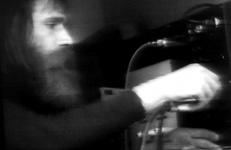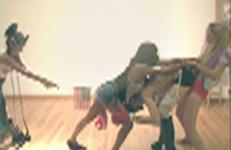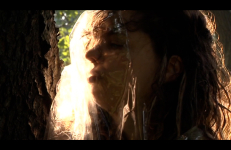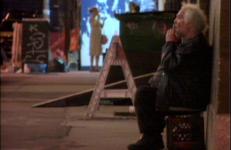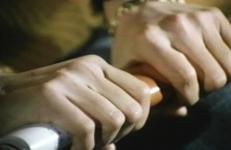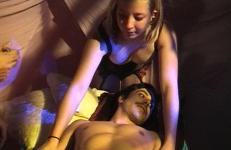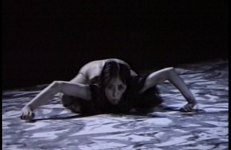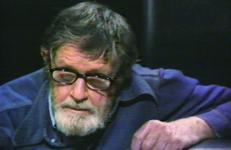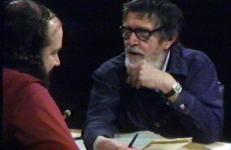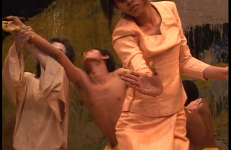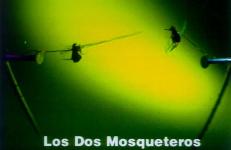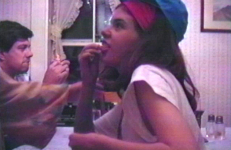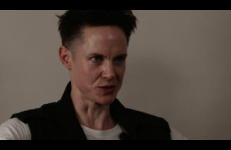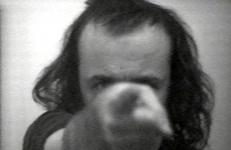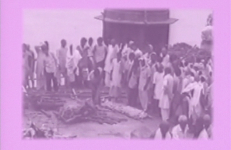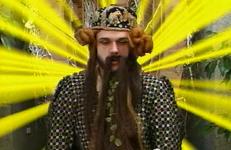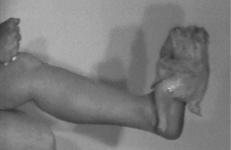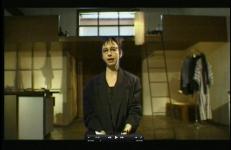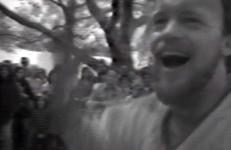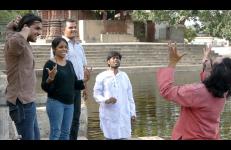In this video the artist states that a public work demonstrates what qualifies as art within his conception. Like Beached, it was also shot in a marshy area near the sea and in sequences separated by dissolves. One sees five different actions related to Broken Off. The artist breaks a tree branch, scrapes and kicks the ground with his foot, snaps a stick in two on a fence, scrapes a stone with his fingernail. At the end he pulls the line plug from the video, drawing attention to the mechanics of the medium.
Performance
In 2002, my troupe, La Pocha Nostra and I were invited to conduct a workshop at Columbia College in Chicago with 15 students and faculty from different departments. At the end of the two-week workshop, we created a large-scale performance-installation with the participants. Canadian video artist Liz Singer was invited to shoot the entire process, from the early workshop exercises, meant to connect students with their bodies and build a sense of community, up to opening night... In this documentary we reveal the working methods and radical pedagogy of La Pocha Nostra.
In 2002, my troupe, La Pocha Nostra and I were invited to conduct a workshop at Columbia College in Chicago with 15 students and faculty from different departments. At the end of the two-week workshop, we created a large-scale performance-installation with the participants. Canadian video artist Liz Singer was invited to shoot the entire process, from the early workshop exercises, meant to connect students with their bodies and build a sense of community, up to opening night... In this documentary we reveal the working methods and radical pedagogy of La Pocha Nostra.
A bruise on her face. The woman has white makeup, bright red lips and dark-rimmed eyes, which are largely covered by her hair. Without uttering a word, she hits her face, head and upper body.
Bubble is a short film performed by Zeena Parkins and the Plastic Girls, Eleanor Hullihan and Erin Cornell in a public park in Brooklyn, NY.
DIRECTOR’S STATEMENT/SUMMARY: This film centers around one performance, when Holland-based musicians, The Ex, visited New York to play a concert. This performance is intercut with city scenes, first from Amsterdam and then New York, of construction sites, street life, and protests against the Iraq war and the Bush administration. The construction site scenes relate to the band's dedication to music as a realm for collaborative building and creative destruction.
Chris Burden came into prominence in the late 1960s, but unlike many of the performance artists of his generation, Burden was interested in empirical and scientific investigations. His goal was to return the control of art making to the artist and to question the relevancy of more established art practices. In this documentary Burden talks about his hard-hitting performances in the ’70s that took a jaded art world by surprise and continues on to discuss the sculptural and installation works of the ’80s.
The audience's engagement with the smallest subtleties and less than (usually considered) spectacular elements of theater is impressive and speaks volumes on the patience and acuity of modern viewers. Their finely tuned sense of humor and rapt and continuous focus warms the cynics' icy exterior. Likewise, the feedback loop of mutual artistic understanding and respect from the performing elements and receptive viewers, and back again, fortifies those who wish to love art and believe it must have revolutionary value. All are satisfied and joyful in the showing of satisfaction.
To counteract the talkie I had done with graduate student the day before, this undergrad project has no dialogue but just a steady stream of images we dreamed up on the spot. A psychodrama that’s heavy on the beefcake, our picture deals with the sexual dementia of a sex addict undergoing hypnotherapy. It’s a mixture of fantasy and desire with some animals thrown in and lots of strange angles of the leading actor’s attributes.
Contains Videofreex tapes Buzzy and the Flute, Buzzy at the Gaslight, Buzzy at the Videofreex Loft, Buzzy Linhart at the Record Plant
This tape includes a mix of content featuring songwriter and recording artist, Buzzy Linhart and his band
Commissioned by Boston Dance Umbrella, this work was created during a month-long residency in Boston. Clayton Campbell painted a mythological scene of the river that a dying person crosses to reach the world of the dead. The piece was first titled as Eye Below but later changed to By The River.
John Cage’s work has had an immeasurable influence on 20th Century music and art, and his formal and technological innovations were tied to his desire to push the boundaries of the art world. In 1951 he initiated the first recording on magnetic tape, and in 1952 he staged a theatrical event that is considered the first Happening. His invention of the prepared piano and his work with percussion instruments led him to imagine and explore many unique and fascinating ways of structuring the temporal dimension of music.
John Cage’s compositions and performances have had a profound influence on generations of musicians and artists. In this tape, he initiates For the Third Time as author Richard Kostelanetz interviews him. “I’ve left the punctuation out, but I’ve distributed it by chance operations on the page, like an explosion,” Cage says. “You can replace the punctuation where you wish.”
Cambodian Stories is Eiko & Koma's multi-disciplinary collaboration with Reyum Painting Collective, young painters who study and work at the Reyum Institute of Arts and Culture in Phnom Penh, Cambodia. In addition to Eiko & Koma, who perform alongside their Cambodian artist colleagues, the creative collaborators include Reyum Institute founder Daravuth Ly, who functions as dramaturg, and Cambodian-born music ethnologist Sam-Ang Sam.
In a world of Internet and high technology, there still remains something so arcane, so simple and extraordinary, so absolutely incredible as a circus of educated fleas. Marvel at Maria Fernanda Cardoso's work as the powerful Brutus (The Strongest Flea on Earth) pulls a locomotive that weighs 160,000 times his own weight. See the flea ballerinas dressed in micro-tutus, dance to the rhythms of Tango! Hold your breath as the highwire artists defy gravity on the tightrope and swing precariously on a miniature trapeze.
In a world of Internet and high technology, there still remains something so arcane, so simple and extraordinary, so absolutely incredible as a circus of educated fleas. Marvel at Maria Fernanda Cardoso's work as the powerful Brutus (The Strongest Flea on Earth) pulls a locomotive that weighs 160,000 times his own weight. See the flea ballerinas dressed in micro-tutus, dance to the rhythms of Tango! Hold your breath as the highwire artists defy gravity on the tightrope and swing precariously on a miniature trapeze.
A family embraces the heart of evil in this Poltergeist re-make/drag show, circa 1992.
In conversation with David Getsy — an art historian focusing on queer and transgender methodologies in sculpture theory and performance history — Cassils discusses their monumental performance artworks and inspirations.
"Pointing at my own image on the video monitor: my attempt is to keep my finger constantly in the center of the screen — I keep narrowing my focus into my finger. The result [the TV image] turns the activity around: a pointing away from myself, at an outside viewer."
— Vito Acconci, "Body as Place-Moving in on Myself, Performing Myself," Avalanche 6 (Fall 1972)
On December 8, 1984, Linda Montano began a 7-year performance titled 7 Years of Living Art, based on the seven Hindu chakras, and performed public and private vows and tests of personal endurance. Upon completing the project, Montano began again and titled the new work Fourteen Years of Living Art. During that time she composed and performed CHAKRAPHONICS, a sonic experience for the chakras. This video can be used as a guide to meditation on the chakras.
This wonderful and wide-ranging saga of New Age sensibilities in conflict with down-and-dirty urges takes the viewer on a roller coaster ride into the freak show world of actors and actresses in need of adequate direction. The cast is flamboyant and floundering in this tale of sickness and motherly love competing for the souls of the sexually ambiguous as they mature into mammals of desire and despair. Witness the majesty of digital wizardry as it attempts to zest up the zombie zeitgeist inherent in these fast-paced productions of desperate means.
In Chicken on Foot, Sobell bounces a chicken carcass as one would a child, periodically crushing eggs (fetal chickens) on her knee. A statement of the displacement of sexual desire on food and women’s bodies, and an expression of female ambivalence about motherhood.
Circle's Short Circuit is an experimental feature-length work with neither a beginning nor an end—the film can be viewed from any random point. It moves through a circle of five interlocking episodes that describe the phenomenon of interruption in contemporary communication through various forms and modes, investigating causes, consequences, and side-effects. Genres shift along the episodic path of this circle, moving from documentary to essay, through collage, simulated live-coverage, and silent film.
A troupe of male and female jugglers and musicians perform for a growing crowd in Central Park, New York, led by Hovey Burgess and Judy Finelli. The sun is shining, and the troupe are skilful, playful, and flirtatious.
Gautam Chatterjee uses the streets, parks, and temple grounds of the city of Varanasi, India, to teach his students a 2000-year old method of acting. Based on Natya Shastra, a treatise written by a quasi-mythical monk Bharat Muni, the instructions aim to intimately connect the actor with the real world. Through deep engagement with the surroundings, people, animals, plants, and phenomena such as waves on the water or patches of sunlight on the ground, the actors work towards creating a truthful representation of the world.




